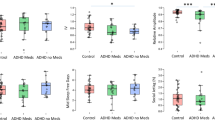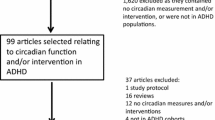Abstract
Prevalence rates of attention-deficit/hyperactivity disorder (ADHD) differ with geographical areas varying in sunlight intensity. Sun- or daylight reaching the retina establishes entrainment of the circadian clock to daylight. Changes herein, hence, alterations in clock alignment, could be reflected indirectly in inattention via sleep duration. We here studied (1) annual variation in inattention at treatment initiation; (2) annual variation in response to ADHD treatment [methylphenidate (MPH)] by day of treatment initiation; and (3) dose dependence. We predicted least baseline inattention during a period of high sunlight intensity implying more room for improvement (i.e., a better treatment response) when sunlight intensity is low. These hypotheses were not confirmed. High-dose treated patients, however, had significantly better attention after treatment than low-dosed treated patients, only when treated in the period from winter to summer solstice. Change in solar irradiance (SI) during low-dosed treatment period was negatively related to attentional improvement. The above described findings were primarily found in inattention ratings and replicated in omission errors on a continuous performance task. Daylight and inattention have been proposed to be related via mediation of the circadian system. One mechanism of MPH may be to enhance sensitivity to the diurnal entrainment to sunlight and the question can be raised whether appropriate lighting could potentiate the effects of stimulants.


Similar content being viewed by others
References
Arns M, van der Heijden KB, Arnold LE, Kenemans JL (2013) Geographic variation in the prevalence of attention-deficit/hyperactivity disorder: the sunny perspective. Biol Psychiatry 74(8):585–590
Roenneberg T, Merrow M (2016) The circadian clock and human health. Curr Biol 26(10):R432–R443
Kantermann T, Juda M, Merrow M, Roenneberg T (2007) The human circadian clock’s seasonal adjustment is disrupted by daylight saving time. Curr Biol 17(22):1996–2000
Vollmer C, Randler C, Di Milia L (2012) Further evidence for the influence of photoperiod at birth on chronotype in a sample of german adolescents. Chronobiol Int 29(10):1345–1351
Arns M, Vollebregt MA (2019) Time to wake up: appreciating the role of sleep in ADHD. J Am Acad Child Adolesc Psychiatry 58(4):398–400
Dijk DJ, Czeisler CA (1994) Paradoxical timing of the circadian rhythm of sleep propensity serves to consolidate sleep and wakefulness in humans. Neurosci Lett 166(1):63–68
Coogan AN, McGowan NM (2017) A systematic review of circadian function, chronotype and chronotherapy in attention deficit hyperactivity disorder. Atten Defic Hyperact Disord 9(3):129–147
Kooij JJ, Bijlenga D (2014) High prevalence of self-reported photophobia in adult ADHD. Front Neurol 5:256
Arns M, Vollebregt MA, Palmer D, Spooner C, Gordon E, Kohn M et al (2018) Electroencephalographic biomarkers as predictors of methylphenidate response in attention-deficit/hyperactivity disorder. Eur Neuropsychopharmacol 28(8):881–891
Coomans CP, Lucassen EA, Kooijman S, Fifel K, Deboer T, Rensen PCN et al (2015) Plasticity of circadian clocks and consequences for metabolism. Diabetes Obes Metab 17(Suppl 1):65–75
Chang A-M, Scheer FAJL, Czeisler CA (2011) The human circadian system adapts to prior photic history. J Physiol 589(Pt 5):1095–1102
Antle MC, van Diepen HC, Deboer T, Pedram P, Pereira RR, Meijer JH (2012) Methylphenidate modifies the motion of the circadian clock. Neuropsychopharmacology 37(11):2446–2455
McGlashan EM, Nandam LS, Vidafar P, Mansfield DR, Rajaratnam SMW, Cain SW (2018) The SSRI citalopram increases the sensitivity of the human circadian system to light in an acute dose. Psychopharmacology 235(11):3201–3209
Parekh PK, Ozburn AR, McClung CA (2015) Circadian clock genes: effects on dopamine, reward and addiction. Alcohol 49(4):341–349
Mendoza J, Challet E (2014) Circadian insights into dopamine mechanisms. Neuroscience 282C:230–242
Green CB, Besharse JC (2004) Retinal circadian clocks and control of retinal physiology. J Biol Rhythms 19(2):91–102
Iuvone PM, Tosini G, Pozdeyev N, Haque R, Klein DC, Chaurasia SS (2005) Circadian clocks, clock networks, arylalkylamine n-acetyltransferase, and melatonin in the retina. Prog Retin Eye Res 24(4):433–456
Wirz-Justice A, Wever RA, Aschoff J (1984) Seasonality in freerunning circadian rhythms in man. Naturwissenschaften 71(6):316–319
Bijlenga D, Vollebregt MA, Kooij JJS, Arns M (2019) The role of the circadian system in the etiology and pathophysiology of ADHD: time to redefine ADHD? Atten Defic Hyperact Disord 11(1):5–19
Lam RW, Levitt AJ, Levitan RD, Michalak EE, Cheung AH, Morehouse R et al (2016) Efficacy of bright light treatment, fluoxetine, and the combination in patients with nonseasonal major depressive disorder: a randomized clinical trial. JAMA Psychiatry 73(1):56–63
Acknowledgements
We acknowledge the iSPOT-A Investigators Group, the contributions of iSPOT-A principal investigators at each site, and the central management team (global coordinator Claire Day, PhD).
Author information
Authors and Affiliations
Corresponding author
Ethics declarations
Conflict of interest
MA reports research grants and options from Brain Resource (Sydney, Australia) and shares from neuroCare Group (Munich, Germany); DP has received income and stock options with the role of science and data processing manager as an employee with Brain Resource Ltd.; EG is founder and receives income as Chief Executive Officer and Chairman for Brain Resource Ltd. He has stock options in Brain Resource Ltd. JKB has been a consultant to/member of advisory board of/and/or speaker for Janssen Cilag BV, Eli Lilly, and Servier in the past years. He is not an employee of any of these companies, and not a stock shareholder of any of these companies. He has no other financial or material support, including expert testimony, patents, royalties. MV, LK, TD, and GE report no financial disclosures.
Ethical approval
The study complies with the principles of the “Declaration of Helsinki 2008,” the International Conference on Harmonization (ICH) guidelines, and the laws and regulations of the country in which the research is conducted, including the principles of “Good Clinical Practice” as outlined in the U.S. Code of Federal Regulations. All sites received approval from their Institutional Review Board (IRB)/Independent Ethics Committee (IEC) prior to participant enrollment and each participant (and/or guardian) provided their informed consent to be involved in the study.
Electronic supplementary material
Below is the link to the electronic supplementary material.
Rights and permissions
About this article
Cite this article
Vollebregt, M.A., Kenemans, J.L., Buitelaar, J.K. et al. Annual variation in attentional response after methylphenidate treatment. Eur Child Adolesc Psychiatry 29, 1231–1236 (2020). https://doi.org/10.1007/s00787-019-01434-1
Received:
Accepted:
Published:
Issue Date:
DOI: https://doi.org/10.1007/s00787-019-01434-1




